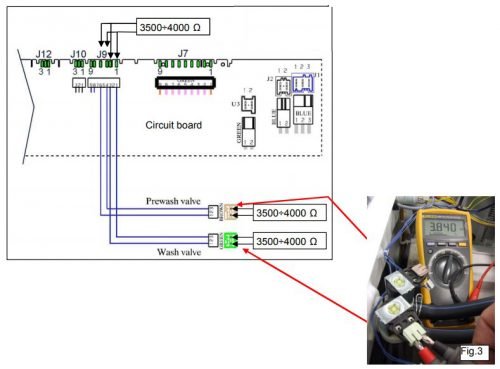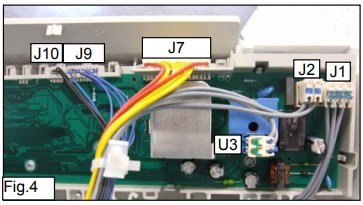E13: Water leakage
Overall maximum water fill time exceeded (the sum of all the water fills between one drain phase and the next, to avoid exceeding the maximum volume)
Tests to be performed:
1. Access the diagnostic cycle and duct water through all the compartment (phases 2,3,4). Is water ducted through all the compartments? Yes – see item 2.a; No – see item 3.a;
2.a Is the drain hose positioned correctly so as not to create the siphon effect? (fig.1) No > Position the drain circuit correctly and restart the diagnostic cycle to check for further alarm conditions.
- Yes > Is the hydraulic circuit efficient (leaks)? No > Repair the hydraulic circuit and restart the diagnostic cycle to check for further alarms.
- Yes > Is the hydraulic circuit of the pressure switch efficient (leaks/blockage)? fig.2 No > Repair the hydraulic circuit of the pressure switch and restart the diagnostic cycle to check for further alarm conditions.
- Yes > Replace the circuit board and restart the diagnostic cycle to check for further alarms.
3.a Do any or all the solenoids fail to function? No > Check that the tap is open, that the mains water pressure is sufficient and that the hoses are correctly connected and not kinked.
- Yes > Is the ohmic resistance of the solenoid about 3.5 – 4.5 KΩ? (measure directly on the solenoid without wiring) see fig. 3 No > Replace the solenoid and restart the diagnostic cycle to check for further alarm conditions.
- Yes > Re-attach the connector and measure about 3.5 –4.5 KΩ on the solenoid wiring connector (circuit board side) see fig. 4-: across J9-3 and J9-1 (washing) and across J9-6 and J9-4 (prewash). Is the solenoid wiring OK? No > Replace or repair the wiring and restart the diagnostic cycle to check for further alarm conditions.
- Yes > Replace the circuit board and restart the diagnostic cycle to check for further alarm conditions




